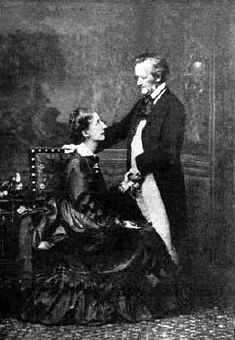|
<<< << -- 3 -- Kelly Ferjutz THE WANDERING TRAVELLER -- >> >>>

Unfortunately, that didn't happen, as Wagner and Cosima were required to flee to Switzerland, but the composer retained the concept, and utilized a good many of Semper's features when Bayreuth was built some years later. Semper was part of the artistic circles that Wagner surrounded himself with, including singers, musicians, artists and architects. Dr Mallgrave of the Illinois Institute of Technology will elaborate on the relationship between these two forceful and artistic men during his lecture on Saturday. Sunday, he'll present an illustrated talk, featuring drawings and sketches of Semper House (in Munich) and Wagner's Festspielhaus at Bayreuth.

Cosima and Richard Wagner
|
Laurie Lashbrook of Akron University will add to her Saturday talk about the Wagner/Liszt connection with a recital on Sunday that explores Wagner's contribution and influence on Lied and Mélodie. These were the pop songs of the day; nearly every composer in the 1800s combined famous poetry with his or her own music. Some of these were in cycles and some were independent songs. The recital will include Dr Paul Transue at the piano.
One of the earliest and most famous of the German Lied is Gretchen am Spinnrade which the seventeen-year-old Franz Schubert set musically to the poem by Wolfgang Goethe in 1814. Wagner used Goethe's poems in his own Sieben Kompositionen zu Goethes Faust Op 5 in 1831-32, when he was eighteen. Schubert's version stood on its own almost immediately; Wagner's never quite made it that far. Wagner's Gretchen was one of the seven poems of Goethe, but, as Dr Lashbook explains, 'The cycle is incomplete, and for different voices and voice combinations: a soprano-alto duet, four-part and even a tenor solo.'
She continues, 'His impact was on others more than doing his own lied, the most famous, of course, being the Wesendonck Lieder'. (These romantic songs were set to poems by Mathilde Wesendonck in 1857, some twenty-five years later, and will be heard in Friday evening's concert by the Canton Symphony Orchestra, conducted by Gerhardt Zimmermann and featuring mezzo-soprano Jane Dutton as the soloist.)
Continue >>
Copyright © 3 May 2007
Kelly Ferjutz, Cleveland USA

|

